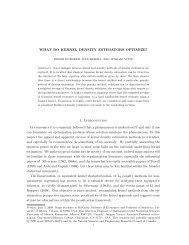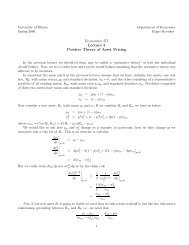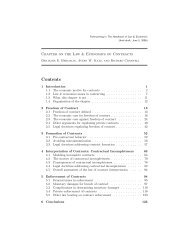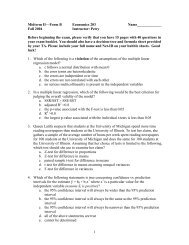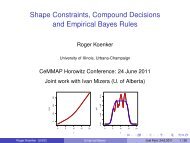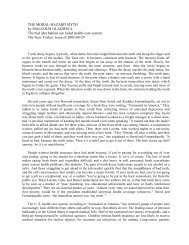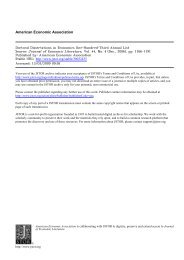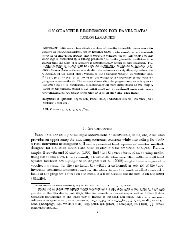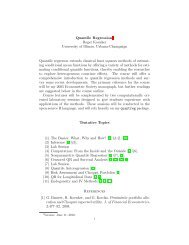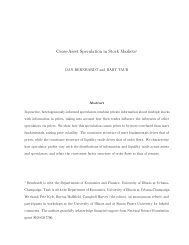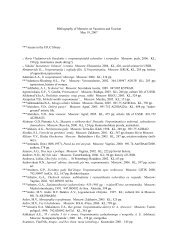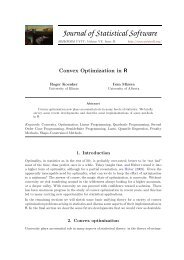1. Introduction - Econometrics at Illinois - University of Illinois at ...
1. Introduction - Econometrics at Illinois - University of Illinois at ...
1. Introduction - Econometrics at Illinois - University of Illinois at ...
Create successful ePaper yourself
Turn your PDF publications into a flip-book with our unique Google optimized e-Paper software.
and the transformed process isRoger Koenker and Zhijie Xiao 21~v() =w 0 ()+ ~ () 0 ,1=2x + o p (1)where the noncentrality process () ~ is simply the martingale transform<strong>at</strong>ion <strong>of</strong>() =' 0 ()F ,10(). Provided th<strong>at</strong> () _ is not in the space spanned by the functionsf1; _' 0 ()g; it is clear th<strong>at</strong> () ~ 6= 0, so the proposed tests have non-trivial power. Figure1 depicts the noncentrality function () its \predicted" version, and its (residual)transformed version () ~ for the normal case. For any given 0 ; the asymptotic localpower <strong>of</strong> the proposed Kolmogorov-Smirnov test is given as followsP (c) =Prsup2Tw 0 ()+ ~ () 0 ,1=2x >c where c is the asymptotic critical value <strong>at</strong> signicance level :Example. It is <strong>of</strong> obvious interest to consider altern<strong>at</strong>ives for which the function 0 (t) =' 0 (t)F ,10(t) is annihil<strong>at</strong>ed by the martingale transform<strong>at</strong>ion. This entailsth<strong>at</strong> _ 0 (t) lie in the linear span <strong>of</strong> f1; _' 0 (t)g, and is evidently s<strong>at</strong>ised for F 0 uniform.More surprisingly, it is also s<strong>at</strong>ised for triangular densities like, f 0 =(1,jxj)I(jxj1). These cases may be regarded as somewh<strong>at</strong> p<strong>at</strong>hological as they have inniteFisher inform<strong>at</strong>ion for both loc<strong>at</strong>ion and scale. Thus, it may not be regarded as toodisturbing th<strong>at</strong> the transform<strong>at</strong>ion performs poorly under such circumstances.5.5. Extensions. The proposed methods can be easily modied to accommod<strong>at</strong>emany other inference problems, including tests for parametric conditional distributionsand tests for conditional symmetry. The theory wedevelop also carries over withminor changes to some analytic nonlinear restrictions in place <strong>of</strong> (4.4) and associ<strong>at</strong>edchanges in the transform<strong>at</strong>ion (4.6). For example, we may modify our hypothesis tothe form(5.4)R() , r = (;):If were known, the previous tests would apply. More generally, if is unknown butmay be estim<strong>at</strong>ed by a p n consistent estim<strong>at</strong>or, n ; then, under regularity conditions(so th<strong>at</strong> admits a Taylor expansion to the second order), the standardized empiricalprocess R n ^() , rn , (; n ) has the following approxim<strong>at</strong>ion^v n () = p n' 0 () R n R > n ,1=2R n ^() , rn , (; n )= v n ()+' 0 ()Z 1 + ' 0 ()F ,10()Z 2 + ' 0 ()s() > Z 3 + o p (1);where s() =@ (; 0 )=@; and Z j = O p (1), j =1; 2; 3: Denoting the set <strong>of</strong> linearlyindependent components <strong>of</strong> functions(;' 0 ();' 0 ()F ,10();' 0 ()s() > );



